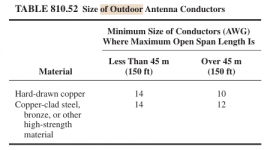I am considering putting up a end fed random wire. I live on a lot with lots of trees from the north corner around the west side to the south corner, about 700 feet. I would like to work 160 through 10 meters. the rig is a Yaesu FT-991A (auto tuner), and I aslo have a manual tuner if needed. I am not going to run very high power, right now 100W max, maybe 500-1000 later one.
Now the questions:
1) What type of wire would be best for this application?
Insulated (will be running trough trees), or bare?
Copper clad steel (multi strand, twisted copper clad or single strand copper clad)?
How long whould the wire be inorder to cover the desired bands (160-10 meters)?
2) The feed will most likly be coax, (about 100 ft). what size balun should be used (I'm thinking about 9:1)
One side of the feed point will be to ground directly below the feed point. (unless it would be better to run a counter poise (how long)?
This antenna will not be straight line, but will have to wonder in a random simicicular path. I'm pretty sure this will be more of an experiment but that's what we do.
I would appreciate and information or suggestions from anyone with any experience with end fed random wire antenna's. of course, information or suggestions from everyone else is welcome.
73, KE5WCT
Mike Wilson
USN RET
Now the questions:
1) What type of wire would be best for this application?
Insulated (will be running trough trees), or bare?
Copper clad steel (multi strand, twisted copper clad or single strand copper clad)?
How long whould the wire be inorder to cover the desired bands (160-10 meters)?
2) The feed will most likly be coax, (about 100 ft). what size balun should be used (I'm thinking about 9:1)
One side of the feed point will be to ground directly below the feed point. (unless it would be better to run a counter poise (how long)?
This antenna will not be straight line, but will have to wonder in a random simicicular path. I'm pretty sure this will be more of an experiment but that's what we do.
I would appreciate and information or suggestions from anyone with any experience with end fed random wire antenna's. of course, information or suggestions from everyone else is welcome.
73, KE5WCT
Mike Wilson
USN RET


